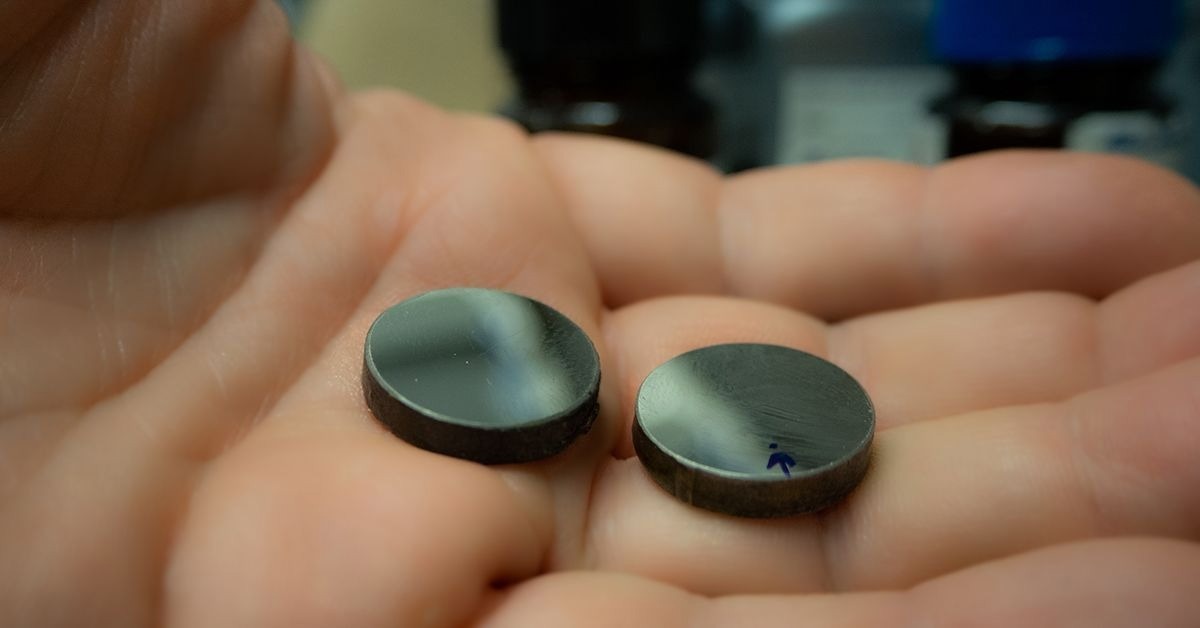Scientists have found a method to enhance the durability and crack resistance of ceramics. The team, led by engineers from the University of California San Diego, achieved this by creating these materials with a combination of metal atoms that have a greater number of electrons in their outer shell. This breakthrough opens the door to enabling ceramics to withstand higher levels of force and stress than previously possible.

Samples of a class of ceramics, known as high-entropy carbides, that have been engineered to withstand more force and stress before breaking. Image Credit: Liezel Labios/UC San Diego Jacobs School of Engineering
Ceramics boast a range of exceptional properties, including their capacity to endure extremely high temperatures, resist corrosion and surface wear, and maintain a lightweight structure. These attributes render them well-suited for a wide array of applications, including aerospace components, protective coatings for engines, and cutting tools. However, their inherent brittleness has remained a longstanding issue, as they are prone to breaking easily when subjected to stress.
Nevertheless, researchers have discovered a solution that could enhance the resilience of ceramics, making them less prone to breakage. This breakthrough was recently published in the journal Science Advances.
The research, overseen by Professor Kenneth Vecchio in the field of nanoengineering at UC San Diego, focuses on a category of ceramics referred to as high-entropy carbides. These ceramics possess atomic structures that are highly disordered and consist of carbon atoms bonded with multiple metal elements derived from the fourth, fifth, and sixth columns of the periodic table. Examples of these metals include titanium, niobium, and tungsten.
The researchers identified that the crucial factor in bolstering ceramic toughness lies in the incorporation of metals from the fifth and sixth columns of the periodic table. This choice is attributed to these metals having a greater number of valence electrons.
The number of valence electrons, which are located in an atom's outermost shell and participate in bonding with other atoms, turned out to be a critical determinant. Through the use of metals with a greater count of valence electrons, the researchers effectively enhanced the material's ability to withstand cracking when exposed to mechanical loads and stress.
Those extra electrons are important because they effectively make the ceramic material more ductile, meaning it can undergo more deformation before breaking, similar to a metal.
Kenneth Vecchio, Professor, Nanoengineering, University of California San Diego
To gain a deeper insight into this phenomenon, Professor Vecchio's team collaborated with Professor Davide Sangiovanni, a Theoretical Physicist at Linköping University in Sweden. Sangiovanni conducted computational simulations while Vecchio's team handled the experimental fabrication and testing of the materials.
The research group explored high-entropy carbides comprising various combinations of five metal elements. Each combination resulted in a different concentration of valence electrons within the material, offering valuable insights into the impact of valence electron count on the material's toughness.
The researchers pinpointed two high-entropy carbides that displayed remarkable resistance to cracking when subjected to loads or stress, primarily due to their elevated valence electron concentrations. One of these compositions included the metals vanadium, niobium, tantalum, molybdenum, and tungsten, while the other variant replaced niobium with chromium in the alloy.
Under mechanical loads or stress, these materials exhibited a capability to deform or stretch, mirroring the behavior of metals rather than the usual brittle response observed in ceramics. When subjected to puncturing or pulling forces, the materials initiated the breaking of bonds, resulting in atom-sized gaps.
However, the surplus valence electrons surrounding the metal atoms underwent a reorganization, effectively bridging these gaps and forming new bonds between adjacent metal atoms. This process preserved the material's structure around the gaps, effectively impeding their expansion and the formation of cracks.
We discovered that there’s this underlying transformation happening at the nanoscale where the bonds are being rearranged to hold the material together. Instead of just cleaving right across the fracture surface, the material slowly frays like a rope would when it is being pulled. In this way, the material can accommodate this deformation that’s occurring and not fail in a brittle manner.
Kevin Kaufmann, Study Co-Author, University of California San Diego
Kevin Kaufmann is a nanoengineering Ph.D. alumnus from Vecchio’s lab.
The primary challenge ahead is to scale up the production of these resilient ceramics for commercial utilization. This development has the potential to revolutionize technologies reliant on high-performance ceramic materials, spanning from aerospace components to biomedical implants.
Moreover, the increased toughness of these ceramics opens doors to extreme applications, such as using them for leading edges on hypersonic vehicles. These tougher ceramics could act as a frontline defense for such vehicles, protecting crucial components from the impact of debris and enhancing their ability to withstand supersonic flights, as articulated by Professor Vecchio.
By addressing a longstanding limitation of ceramics, we can greatly expand their use and create next-generation materials that hold the potential to revolutionize our society.
Kenneth Vecchio, Professor, Nanoengineering, University of California San Diego
The study was funded by the Swedish Research Council (grants VR-2018-05973 and VR-2021-04426), Competence Center Functional Nanoscale Materials (grant 2022-03071), Olle Engkvist Foundation, UC San Diego Department of NanoEngineering’s Materials Research Center, National Defense Science and Engineering Graduate Fellowship Program, ARCS Foundation (San Diego Chapter) and The Oerlikon Group.
Journal Reference
Sangiovanni, D., et al. (2023). Valence electron concentration as key parameter to control the fracture resistance of refractory high-entropy carbides. Science Advances. doi.org/10.1126/sciadv.adi2960.
Article Revisions
- Jan 6 2025 - Meta Description has been updated to fall inline with Google recommendations and a malformed link has been repaired.